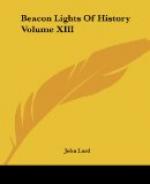We can only briefly refer to the other dramatis personae introduced to us, who are among the notable historical characters that figure during Mary Tudor’s reign. They are those who take part in the incidents, religious, civil, and political, of the period, and are, for the most part, both in speech and bearing, the portraits familiar to us in Mr. Froude’s history. Of these the most pleasing is the Princess Elizabeth, whose portrait is drawn with masterly skill, and engages our interest as the fortunes of its original oscillates “’Twixt Axe and Crown":—
“A
Tudor
Schooled by the shadow
of death, a Boleyn too
Glancing across the
Tudor.”
But, aside from the interest in the safety of her person, which is in constant jeopardy from the jealousy of her half-sister, Elizabeth wins upon the reader by her modest, maidenly bearing, her frankness of manner, and by a playfulness of disposition which readily adapts itself to the restraints which the Queen is ever placing upon her person, and which endears her to the people, who, could the hated Mary be got rid of, would fain become her subjects. The civil strife of the period furnishes material for some powerful passages, which are wrought up with excellent effect, and in this connection Sir Thomas Wyatt, Sir Thomas Stafford, the Earl of Devon, Sir William Cecil, and other historical personages appear upon the stage. The other incidents introduced are those which attach themselves to the religious persecutions of the time, and which brought Cranmer to the stake, and give play to the papal intrigues of Pole, Gardiner, and the emissaries of the Spanish court. The second and third scenes in the fourth act devoted to Cranmer, which detail his martyrdom, are hardly so satisfactory as we think they might have been, though the poet here again follows closely the historical accounts. The scenes, however, give occasion for the introduction of a couple of local gossips whose provincial dialect and keen interest in the national and religious policy of the time, here as in occasional street scenes, are cleverly portrayed. This sapient reflection in the mouth of one of these gossips, Tib, is a specimen at hand:—
“A-burnin’ and a-burnin’, and a-making o’ volk madder and madder; but tek thou my word vor’t, Joan,—and I bean’t wrong not twice i’ ten year,—the burnin’ o’ the owld archbishop ‘ill burn the Pwoap out o’ this ’ere land for iver and iver.”
Philip we have not spoken of; but he fills such a hateful niche in the historical gallery of the time, and the poet introduces him but to act his pitiful role, that we pass him by, though many of the grandest passages in the drama are those which give expression to Mary’s passionate love for him, and her longing desire for an issue of their marriage, which afterwards culminates in her madness and death.
We have to speak of but one other character in the drama, whose death, it has been said, was sufficient to honor and to dishonor an age. The beautiful Lady Jane Grey appears for a little among the shadows of the poem, and moves to her tragic fate.




